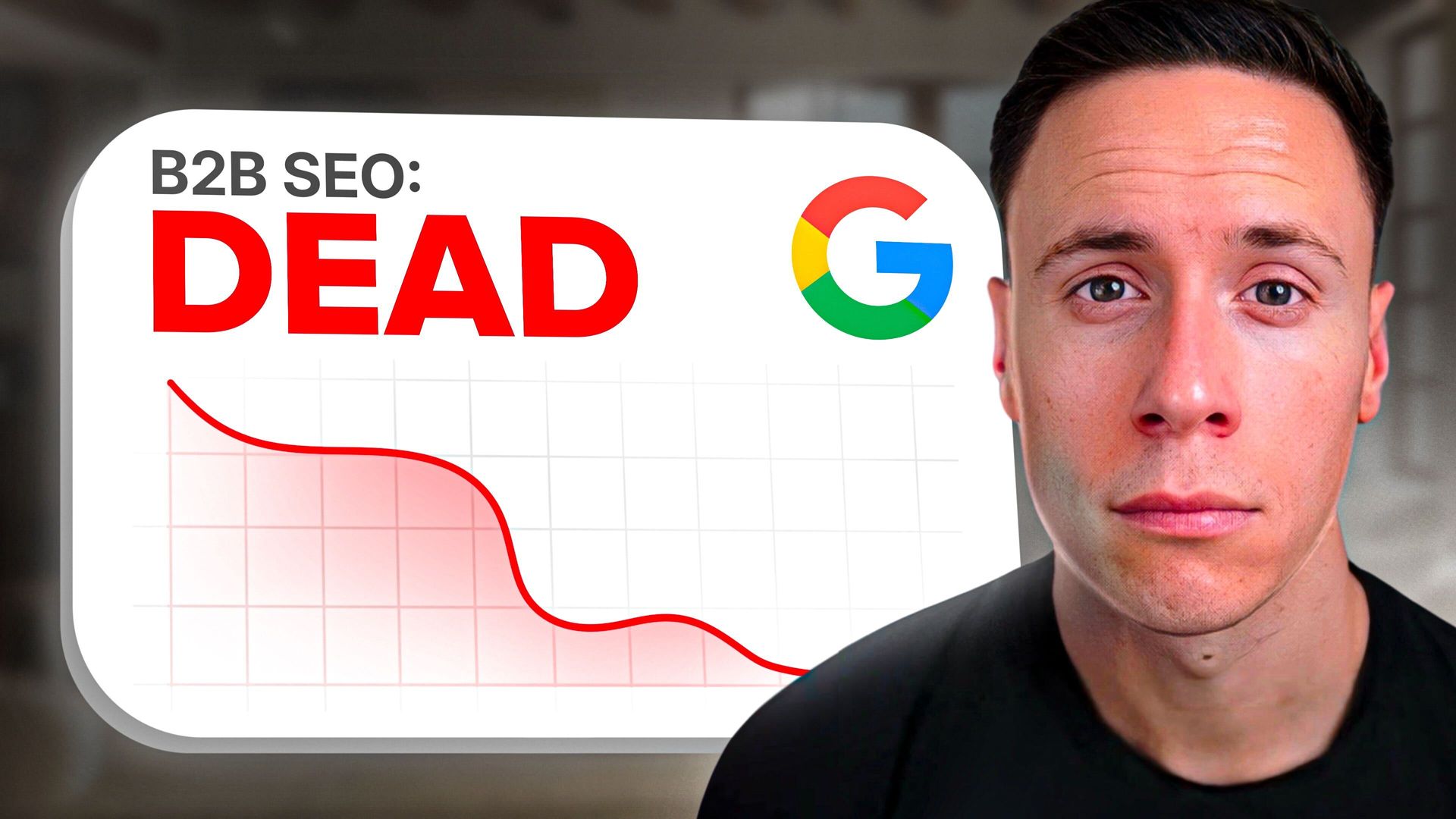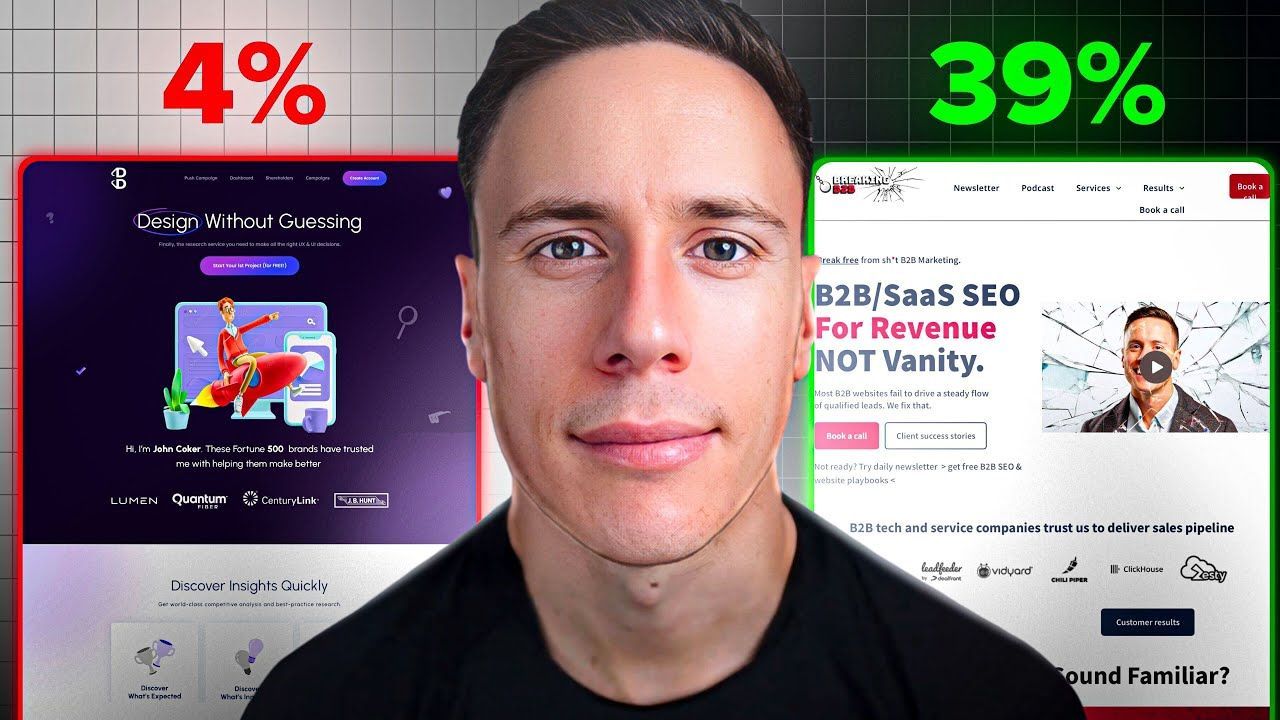Table of Contents
Ready To Grow Organic Pipeline & Revenue?
See if we can scale your organic pipeline from SEO as quick as 90 days.
Quick Summary
Looking to Perform a Structured B2B SEO Audit for Your Business?
A B2B SEO audit helps you identify what’s holding your website back from higher rankings and attracting the right leads. Achieving strong search engine rankings and qualified leads requires more than just basic SEO tactics. A comprehensive SEO audit uncovers technical issues, optimizes content, and enhances your website’s overall performance.
In this Breaking B2B step-by-step guide, we’ll walk you through conducting an effective B2B SEO audit to ensure your site meets SEO best practices and aligns with your target audience's needs.
By focusing on the finer details, you'll uncover hidden opportunities, resolve potential issues, and position your business for long-term growth and success.
Why Listen to Us?
At BreakingB2B, we specialize in comprehensive B2B SEO audits that uncover ranking obstacles and growth opportunities. We don’t just identify issues, we implement solutions that improve technical health, content performance, and search authority.
For example, we helped a
B2B SaaS company rank #1 for ‘alternative’ keywords in just 30 days with a full SEO roadmap that included a technical audit. In this guide, we share what works.
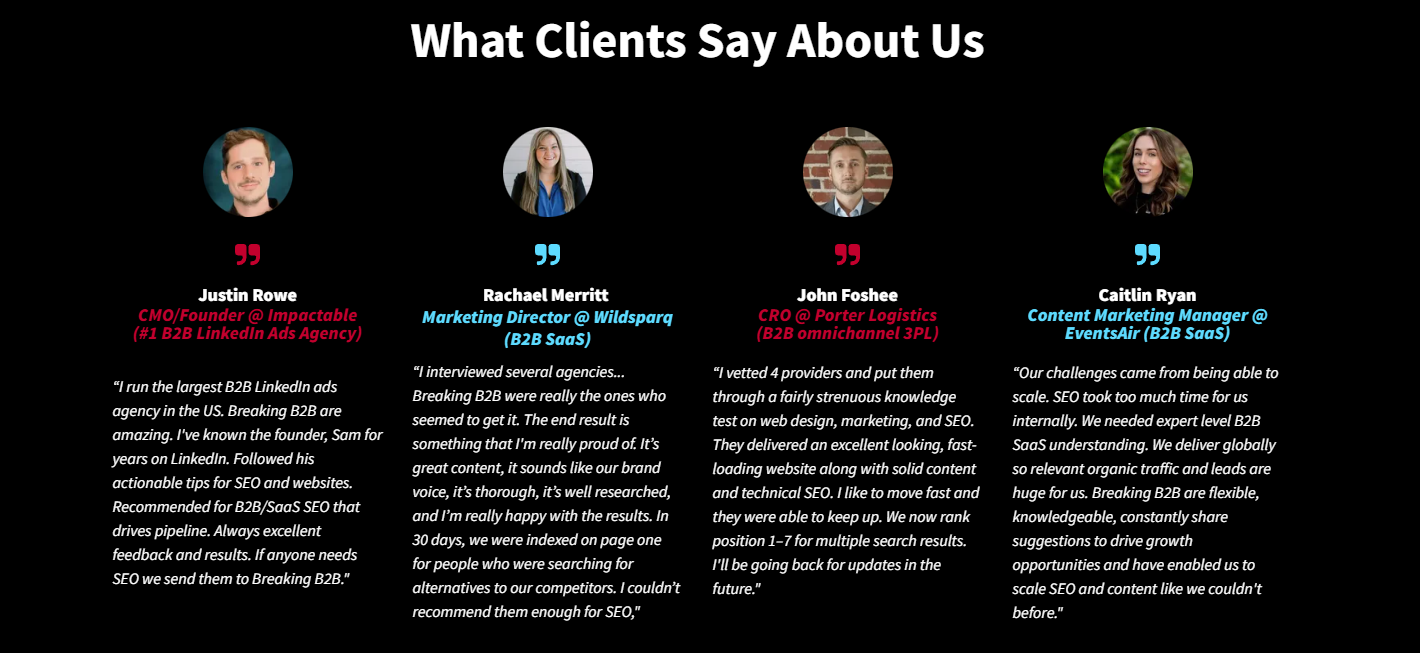
What is a B2B SEO Audit?
A B2B SEO audit is a structured analysis of your website’s search performance, identifying technical, content, and backlink issues that affect rankings. It ensures your site meets SEO best practices, helping you attract and convert the right business customers.
Think of it as a health check for your website. Slow pages, poor mobile experience, or outdated keywords? They’re costing you visibility and leads. An audit helps you spot and solve these problems before your competitors do.
Unlike B2C, B2B SEO is all about long sales cycles and decision-makers. Regular audits keep your strategy sharp, ensuring search engines, and your ideal clients can find you.
The audit typically covers several key areas:
- Technical SEO: This includes checking the website’s structure, speed, mobile optimization, crawlability, and indexing issues. It's essential to ensure search engines can easily access and understand the website.
- On-Page SEO: This focuses on evaluating individual pages for keyword optimization, meta tags, header tags, internal linking, content quality, and user engagement factors.
- Content Quality: The audit examines whether the content meets the needs of target audiences, aligns with search intent, and is structured to drive traffic and conversions.
- Backlink Profile: It assesses the quality and quantity of backlinks pointing to the website. High-quality backlinks from relevant and authoritative sites can improve rankings.
- Competitive Analysis: The audit includes looking at competitors’ SEO performance to identify gaps and areas where your site can improve.
-
By identifying and addressing these issues, a B2B SEO audit ensures your website is fully optimized to attract, engage, and convert the right leads, ultimately driving business growth.
How to Perform an Effective B2B SEO Audit
Step 1: Technical SEO Audit
The first step in an SEO audit is to assess the technical aspects of your search engine. A technical SEO audit ensures search engines can crawl, index, and rank your B2B site effectively. Even the best content won’t perform if your site has slow load times, poor mobile usability, or indexing issues.
Here’s how we approach technical SEO:
- Site Speed and Core Web Vitals: Google prioritizes fast, user-friendly sites. We use PageSpeed Insights and Lighthouse to find slow-loading elements, then optimize images, enable caching, and minimize JavaScript bloat.
- Mobile Optimization: Since over 70% of B2B buyers research on mobile, we ensure your site passes Google’s Mobile-Friendly Test, fixing display issues, unresponsive layouts, and poor tap targets.
- Crawlability and Indexing: Crawlability is how easy it is for search engines to read your website pages. Using Google Search Console’s Coverage Report, we identify unindexed pages, fix orphaned content, and submit updated XML sitemaps to improve search visibility.
- Structured Data: We optimize schema markup for product pages, case studies, and FAQs to improve search presence and engagement.
At Breaking B2B, our
performance-driven B2B SEO service doesn't just diagnose and fix technical issues, we also ensure these optimizations lead to measurable ranking improvements and better user experience.

Step 2: On-Page SEO Audit
A technically sound site is important, but so is having a strong on-page SEO. A combination of both is the much-needed recipe for ranking on SERPs. Our goal here is to ensure that every page targets the right keywords, search intent, and user engagement signals to improve visibility and conversions.
Here are the key areas we evaluate:
- Title Tags and Meta Descriptions: For optimal results, each page must have a unique, keyword-optimized title (50-60 characters) and a compelling meta description (120-160 characters) to increase CTR.
- Header Structure: A proper H1-H2 hierarchy improves both readability and keyword relevance, helping search engines understand content structure. So, we adopt H1 for the primary heading and H2-H4 for logical subheadings.
- Keyword Optimization: Overstuffing hurts rankings. Focus on semantic relevance and user intent. We review keyword placement to ensure that primary keywords are positioned naturally in titles, headers, and the first 100 words of content.
- Internal Linking: Orphaned pages adversely affect the crawlability, authority distribution, and user engagement of websites. To avoid this, we link related content strategically and holistically across the entire website.
We’ve tailored our on-page SEO strategies to B2B sales funnels with a focus on improving the user experience for better engagement, dwell time, and conversions. With these, we ensure landing pages, product pages, and blogs are optimized for both search engines and decision-makers.
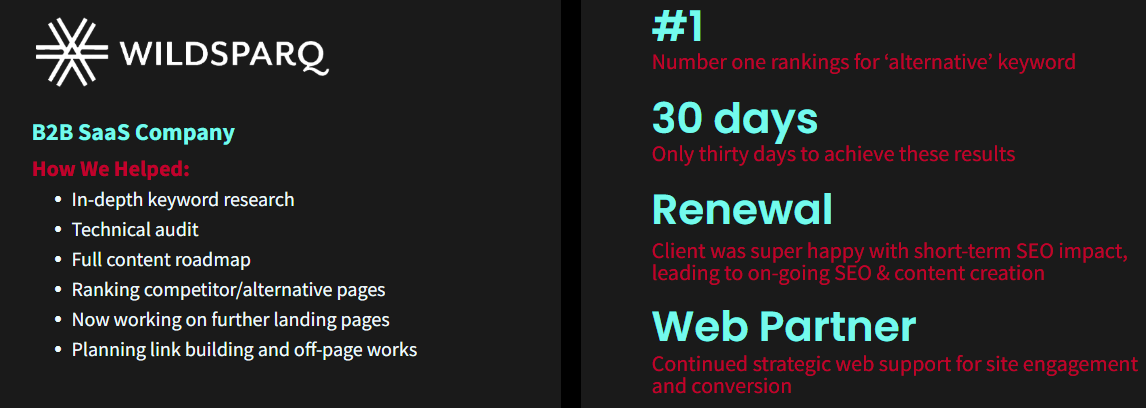
Step 3: Content Quality Audit
Even if your site is technically sound and well-optimized, weak content will limit rankings and conversions. Therefore, it’s crucial to improve content quality so that they rank, engage, and convert.
We adopt an extensive B2B content audit process that identifies gaps, outdated materials, and underperforming assets. It ensures that every page serves both search intent and buyer needs.
Here’s how we refine content for SEO and conversions:
- Relevance and Depth: B2B buyers need detailed, research-backed content. So, we use Google’s Search Console and engagement metrics to flag low-performing pages, especially those with thin, outdated, or generic content, for rewriting or consolidation.
- Search Intent Alignment: A blog targeting decision-makers shouldn’t read like an entry-level guide. Our content strategy ensures that decision-makers get the right level of detail, whether it’s C-suite thought leadership or technical deep dives for specialists.
- Keyword and Topic Optimization: A B2B SaaS site, for example, should have structured content hubs around core solutions. To achieve this, we review keyword density, semantic relevance, and topic clustering.
- Engagement Metrics: High bounce rates and low time-on-page signal weak content. We pick up these issues by diagnosing content structure, readability, and other UX issues using heatmaps and session recordings.
Our SEO-first content approach ensures that your content ranks while supporting the sales funnel, delivering the right message to the right audience at the right time.
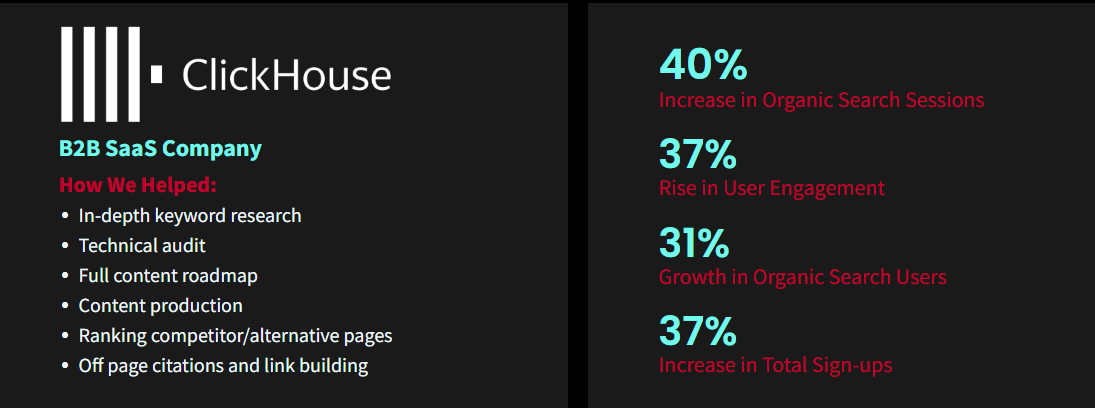
Step 4: Backlink and Authority Audit
Strong backlinks signal trust and authority, but low-quality links can damage your rankings. A B2B backlink audit ensures your link profile supports long-term SEO goals without triggering penalties.
We start by analyzing your backlink profile to:
- Remove Toxic Links: We identify spammy, irrelevant, or paid links and disavow them to prevent penalties.
- Fix Link Authority Distribution: A backlink from a niche-specific B2B site has more value than generic coverage. So, we want to secure high-authority, niche relevant backlinks that drive trust and rankings.
- Optimize Anchor Text: We also ensure that anchor texts reflect natural keyword variations without over-optimization. This helps to avoid costly Google penalties.
-
The goal here is simple–instead of chasing links indiscriminately, we build relationships for quality backlinks. Our approach emphasizes high-authority, industry-specific link acquisition through strategic content collaborations and personalized outreach.
Step 5: Competitive Analysis
Your competitors aren’t just ranking, they’re actively improving their SEO. Therefore, your SEO audit strategy must include a competitive SEO analysis that helps you understand where competitors outperform you and how to close the gap.
Here are the key areas to analyze in this step:
- Keyword Gaps: We identify keywords where competitors rank but you don’t. The right tools and approach can uncover missed opportunities.
- Backlink Profiles: We examine competitor link-building strategies. Are they earning links from high-authority sites, guest posting, or using PR strategies? Then, we replicate or outperform their strategy.
- Content Performance: We compare their pillar pages, case studies, and blogs. Are they producing more in-depth or data-driven content? The goal here is to understand why they rank higher.
- SERP Features: We check if competitors own featured snippets, People Also Ask results, or video carousels, then we optimize your content to compete.
Competitive analysis will help you dominate the search landscape in your industry. Breaking B2B specializes in
data-driven SEO strategies that help clients reverse-engineer competitor success. Our approach to competitive analysis ensures B2B companies identify content gaps, improve domain authority, and outrank key rivals.
Step 6: SEO Performance Tracking
The last stage of the process is performance tracking. After working with hundreds of B2B businesses over the years, we’ve realized that SEO success is not set-and-forget. It requires ongoing tracking, analysis, and refinement to stay effective.
Without clear performance metrics, you won’t know which efforts drive results and which need improvement. Here’s what we track to optimize SEO results:
- Organic Traffic and Click-Through Rate (CTR): We check if pages are gaining or losing visibility and then optimize meta descriptions and titles to increase click-through rates.
- Keyword Movements: We track position changes in keyword tracking systems. Once we identify ranking drops due to a shift in keywords positions, we update content accordingly.
- Engagement and Conversions: High traffic is meaningless without conversions. We analyze bounce rate, session duration, and goal completions to measure engagement quality.
We help B2B companies refine their SEO strategy by using performance data to make data-driven optimizations. We focus on ranking stability, content refinement, and ongoing A/B testing to ensure SEO delivers measurable business outcomes.
Best Practices for Conducting a B2B SEO Audit
To get the most out of your audit, keep these key best practices in mind as you work through the process.
- Prioritize High-Impact Issues First: It’s tempting to fix everything at once, but not all SEO problems are equal. Start with technical roadblocks like crawl errors, indexing issues, and slow load times. Without a strong foundation, even the best content and backlinks won’t help your rankings.
- Map Keywords to the Sales Funnel: Not every visitor is ready to buy. B2B buyers follow a longer decision-making process, so your keywords should match their journey. Focus on informational queries for awareness, solution comparisons for mid-funnel, and decision-stage keywords to convert leads.
- Leverage Data for Content Updates: Don’t assume older content needs a rewrite. Use Google Analytics, heatmaps, and engagement data to decide what to update. Pages with strong historical performance often need small tweaks, not a full overhaul, to regain traffic and rankings.
- Evaluate Backlinks Beyond Quantity: A few high-authority, industry-specific links are worth far more than hundreds of low-quality backlinks. Instead of chasing numbers, focus on earning relevant, trusted links that reinforce your expertise.
- Validate Changes with A/B Testing: SEO is part science, part experiment. Instead of assuming a change will improve rankings, test different title tags, internal linking structures, and content formats to see what actually drives results. Data beats guesswork every time.
Optimizing for Success with the Power of a B2B SEO Audit
A B2B SEO audit uncovers the technical, content, and authority gaps preventing your website from ranking and converting effectively. By following this structured approach, you can identify weaknesses, refine your strategy, and stay ahead of competitors.
SEO for B2B is not just about rankings, it’s about targeting decision-makers, aligning content with the buyer’s journey, and maintaining a strong digital presence. For businesses looking to maximize results, Breaking B2B provides expert-led audits designed to drive measurable growth.
Ready to optimize your SEO strategy?
Let’s talk.






